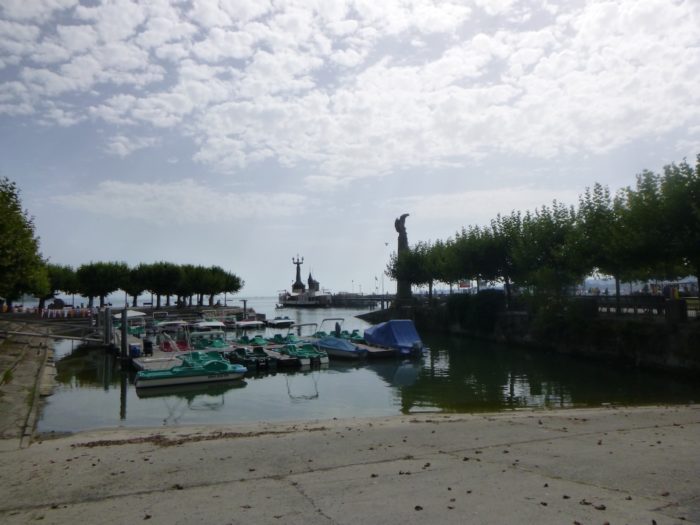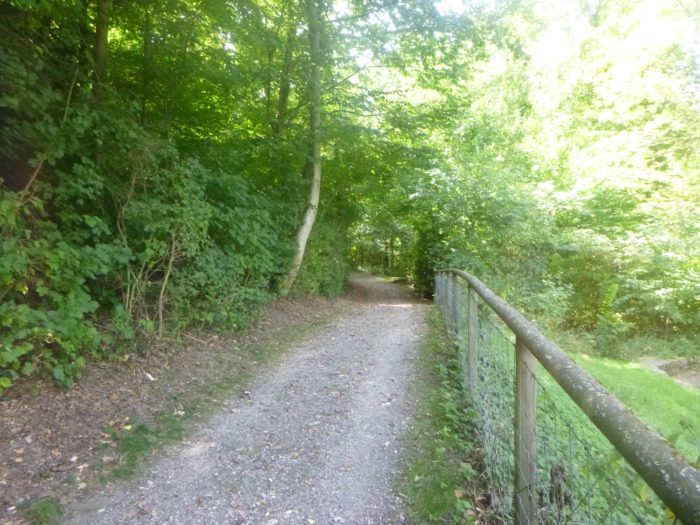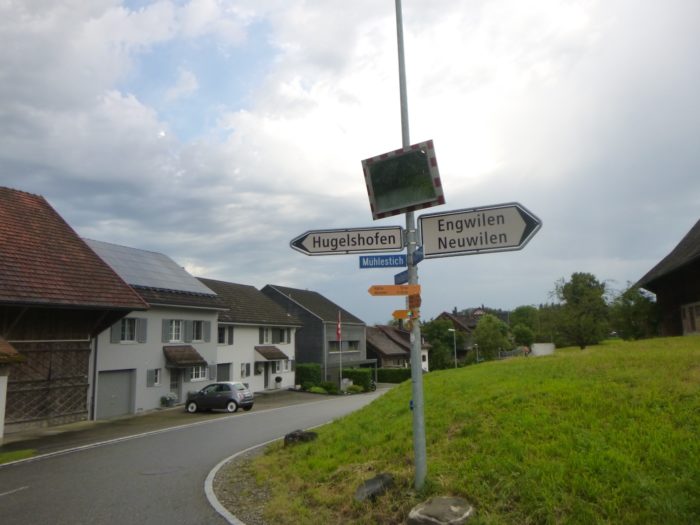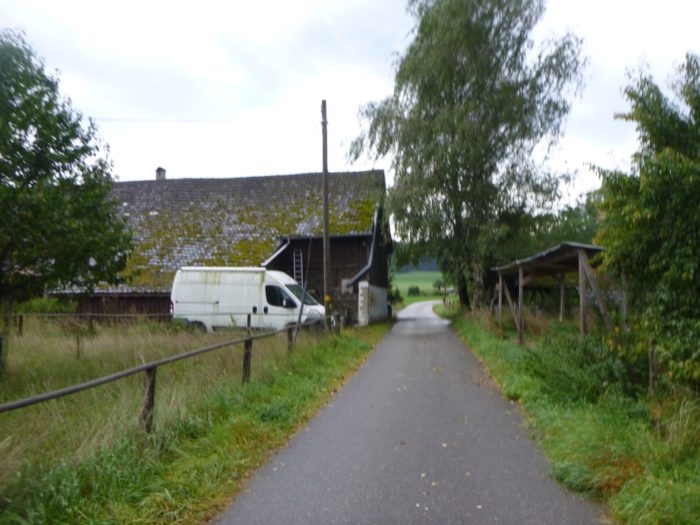From Germany to Switzerland
DIDIER HEUMANN, ANDREAS PAPASAVVAS

We divided the course into several sections to make it easier to see. For each section, the maps show the course, the slopes found on the course, and the state of the route (paved or dirt roads). The courses were drawn on the « Wikilocs » platform. Today, it is no longer necessary to walk around with detailed maps in your pocket or bag. If you have a mobile phone or tablet, you can easily follow routes live.
For this stage, here is the link:
https://fr.wikiloc.com/itineraires-randonnee/de-koblenz-a-marstetten-dorf-par-la-via-jacobi4-152708377
|
Not all pilgrims are necessarily comfortable using GPS or navigating routes on a mobile device, and there are still many areas without an internet connection. For this reason, you can find several books on Amazon dedicated to the major Via Jacobi 4 route, which runs through the heart of Switzerland and over the Brünig Pass. The first guide leads pilgrims through the German-speaking part of Switzerland up to Fribourg, while the second continues through French-speaking Switzerland to Geneva. We have also combined these two books into a compact, lighter, and highly practical version. While the descriptions have been slightly condensed, they remain detailed enough to guide you step by step along the way. Recognizing the importance of traveling light, this latest edition has been designed to provide only the essentials: clear and useful information, stage by stage, kilometer by kilometer. The stages have been carefully adjusted to ensure accessibility and alignment with available lodging options. These books go beyond simple practical advice. They guide you kilometer by kilometer, covering all the crucial aspects for seamless planning, ensuring that no unexpected surprises disrupt your journey. But these books are more than just practical guides. They offer a complete immersion into the enchanting atmosphere of the Camino. Prepare to experience the Camino de Santiago as a once-in-a-lifetime journey. Put on a good pair of walking shoes, and the path awaits you.
|

|
 |
If you only want to consult lodging of the stage, go directly to the bottom of the page.
Situated at the southernmost tip of Germany, Konstanz is a city steeped in history and blessed with exceptional natural beauty. Nestled on the shores of Lake Konstanz (Bodensee in German), it shares its borders with Switzerland, giving it a unique character at the crossroads of cultures and traditions. The jewel of the city is its Old Town (Altstadt), a maze of narrow alleys lined with historic buildings that narrate tales of the past. Remarkably, Konstanz was spared from bombing during World War II, which accounts for the extraordinary preservation of its ancient center. The city is distinguished by a mix of architectural styles that reflect the various epochs through which it has developed. Konstanz is also renowned for being the site of the Council of Constance, held from 1414 to 1418, a major event in Christian history aimed at ending the Western Schism. The imposing Konzilgebäude, where the council meetings took place, is now a historically charged site that attracts many visitors. Beyond its rich historical heritage, Konstanz captivates with its exceptional lakeside location. The city serves as an ideal starting point for boat excursions on the lake, offering spectacular views of the Swiss Alps.
Konstanz, Germany, and Kreuzlingen, Switzerland, share more than just a border. These two towns, positioned on either side of the German-Swiss border, maintain close ties and serve as an interesting example of cross-border cooperation. Thanks to their immediate proximity—separated only by a few streets or parks—residents and visitors move freely between the two, thus facilitating the integration of both communities. Daily, inhabitants of Konstanz and Kreuzlingen enjoy the benefits of each city. People often cross the border to work, study, shop, or for recreation, taking advantage of differences in prices, products, and cultural offerings. This fluidity has fostered a strong economic and social interdependence. The two towns work closely together in various areas such as transportation management, environmental protection, emergency services, and regional tourism. Here, the blend is so complex that it is sometimes hard to tell whether one is in Switzerland or Germany, as the two countries often seem to merge into one. However, for pilgrims, the journey begins by traversing the German city before reaching the Swiss town.
The question arises: Is it better to go to Rapperswil via Konstanz or via Rohrschach? For us, the dilemma has no real solution. The journey is much more appealing via Rohrschach, with its enchanting passage through St. Gall and Toggenburg. The route via Konstanz, on the other hand, is not without interest either. While the crossing through Kreuzlingen at the start of the journey is monotonous, the Thurgovian countryside that follows is beautiful, with the Hörnli pass as a major point of interest.
.

Difficulty level : The journey alternates between urban and rural settings, with relatively modest elevation changes (+203 meters / -169 meters). Naturally, the Swiss Way of St. James avoids high mountains and Alpine passes. However, being in Switzerland—a country of mountains and high hills—rare are the stages on flat terrain, except for this first stage. The only significant challenge, albeit a minor one, is the climb of the Way of the Cross upon leaving Kreuzlingen.
State of the Via Jacobi: In this stage, the routes on asphalt exceed those on paths:
- Paved roads: 12.0 km
- Dirt roads : 8.0 km
Sometimes, for reasons of logistics or housing possibilities, these stages mix routes operated on different days, having passed several times on these routes. From then on, the skies, the rain, or the seasons can vary. But, generally this is not the case, and in fact this does not change the description of the course.
It is very difficult to specify with certainty the incline of the slopes, whatever the system you use.
For those seeking « true elevations » and enthusiasts of genuine altimetric challenges, carefully review the information on mileage at the beginning of the guide.

Section 1: From Konstanz to Kreuzlingen

Overview of the route’s challenges: a straightforward route.

|
As pilgrims journey from Germany and cross into Konstanz, they are often greeted by the radiant silhouette of the casino, a still sentinel at the edge of Lake Constance.
|
 |
 |
| Like timeless travelers, they follow the lakeshore, guided by the whisper of the water to a bridge that spans the Rhine, seeming to connect two worlds: one bathed by the lake’s waves and the other rooted in the vibrant heart of Konstanz. |
 |
 |
Their route then takes them across this bridge, where the fates of those traveling between Germany and Switzerland intertwine.
|
 |
 |
| They are propelled by the regular breath of trains rushing across the bridge. |
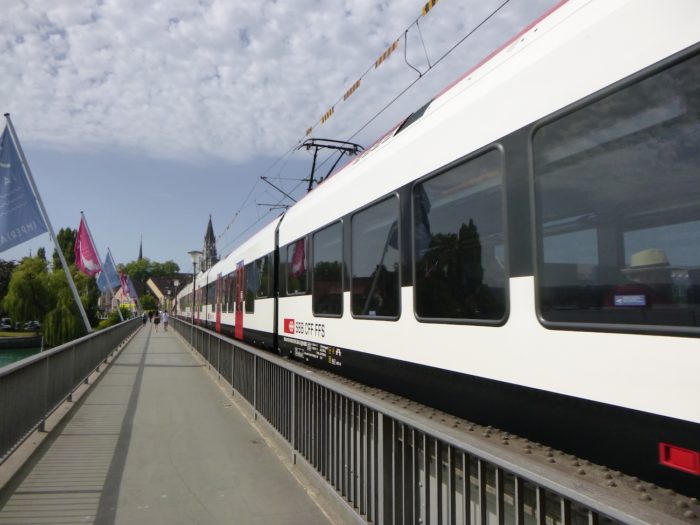 |
 |
Here, although feet still tread on German soil, eyes already catch the first signs of Switzerland: yellow signs, directional sentinels, pointing the way to Kreuzlingen, the tranquil border guardian.

| A canal, a narrow ribbon of water trapped between the lake and the town of Konstanz, borders the route. The route opts for discretion, following the canal, resisting the pull of the city’s throbbing heart. |
 |
 |
| Soon, the course turns into a verdant haven, entering a park where tall trees seem to share stories with those who pause to listen, before revealing a marina where boats dance an eternal invitation to voyage. |
 |
 |
| Exiting this tranquil refuge, the journey resumes, leading to the port of Konstanz. There, a ceaseless ballet of ships weaves unseen ties between Switzerland and Germany, in a port where the horizon seems to promise the opening of both worlds. |
 |
 |
| The direction remains unchanged, steadfastly pointing towards Kreuzlingen. |
 |
 |
| The port vibrates with a myriad of cultural and recreational activities, painting life in bright colors and joyful sounds. |
 |
 |
| Just steps away lies one of the borders. The two cities share more than geography; they exchange lives, laughter, and dreams through numerous passages that connect these sister cities—Konstanz, vibrant with its 85,000 souls, and Kreuzlingen, more modest but equally lively with its 24,000 beating hearts. Here, the railway hugs the coast, a silent witness to the comings and goings. |
 |
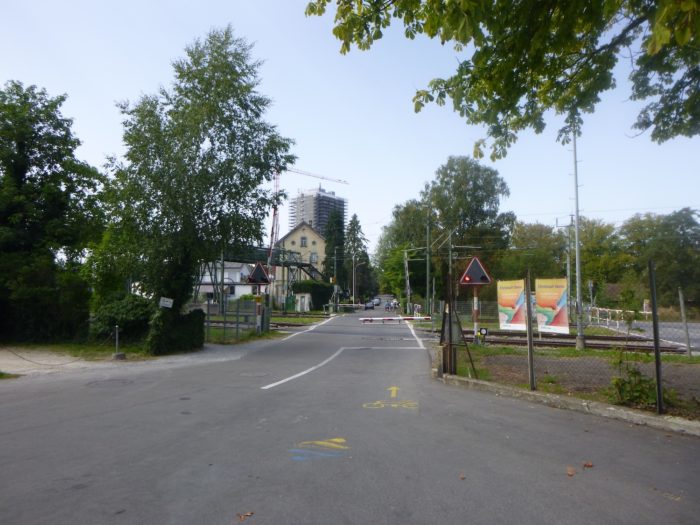 |
| The route, like a whispered lament between the iron rails and the changing waters of the lake, weaves a mesmerizing dialogue between the immutable and the fluid. In this eternal dance, the railway stretches like a ribbon of steel, an impassive witness to the passing time, while the lake, with its shifting reflections, murmurs its mysterious secrets. |
 |
 |
| Further along, it reaches the port of Kreuzlingen, slightly less frequented, but still imbued with the usual charm of lakeside locations. |
 |
 |
Kreuzlingen also boasts a vast recreational area by the lake, Seeburgpark, a witness to simple joys and shared pleasures, although the road only casts a fleeting shadow here.

| As the route progresses, it veers away from the shore to cross the railway tracks, plunging into the heart of Kreuzlingen in search of its soul. |
 |
 |
| Soon, the pilgrim reaches the Kreuzlingen-Hafen station, where the sleek silhouette of this railway halt emerges like a contemporary lighthouse, rising from the urban horizon with the discretion of a guardian attentive to the movements and exchanges that animate the region. Positioned at the heart of a network of vital rail arteries, this station plays a crucial role for lakeside residents, offering them a vital link to other activity hubs in the region. |
 |
 |
| Here the route isn’t really marked. For the time being, we haven’t seen any signs of Via Jacobi 4, but that’s not a problem. We will help you avoid getting lost. Simply head towards the central station. Direction signs, often represented by a yellow diamond, usually indicate major pathways in Switzerland. Therefore, head towards the city center following Pestalozzistrasse. |
 |
 |
| The street stretches discreetly in front of the Dreispitz sports and cultural center, where the crowd does not gather in numbers… |
 |
 |
| …continuing its journey to Bärenplatz, where a vast parking area spreads out like a sea of asphalt. Beyond this terrestrial space dedicated to mobility, the Catholic Basilica of St. Ulric and Santa Anna stands proudly. Built in the 12th century, this centuries-old church bears the scars of time, witnessing the vicissitudes of history. Destroyed during the ravages of the Hundred Years’ War, it bravely rebuilt its stones, one by one, over the centuries, in an act of resilience and unwavering faith. In the predominantly Protestant canton of Thurgau, this Catholic edifice stands as a spiritual beacon, reminding that despite denominational differences, religious diversity is a treasure to cherish. |
 |
 |
| The route, like a thread of Ariadne, unfolds from square to square, brushing past the Protestant church, in a town where the heart beats to the rhythm of a fragmented, less vibrant center. |
 |
 |
| Soon after, the road delves near the Rosenegg district, where a museum, schools, and the modest premises of the local television station stand silently. This part of the urban crossing seems to stretch indefinitely, like a slow stroll through anonymous streets and gray facades. |
 |
 |
Section 2: From Kreuzlingen to the Way of the Cross

Overview of the route’s challenges: a straightforward route, followed by the steep climb of the Way of the Cross.

|
You will need to travel nearly half a kilometer through melancholy-tinted streets, where life seems withdrawn, shops are absent, appearing as erased silhouettes in the urban landscape…
|
 |
 |
… before reaching the central station, where the timid bustle of travelers lends a subtle pulse to the atmosphere.
|
 |
 |
As predicted, there you will find, like a beacon in the fog, the first marker of the Via Jacobi 4, emerging from stone as an unchanging symbol of guidance. A reassuring signpost guides the pilgrim on their quest, indicating the route to follow with certainty. Märstetten is 3 hours and 40 minutes from here.
It is important to understand that the Swiss who embark on the Via Jacobi most likely start their journey here at the train station, rather than by the lake.
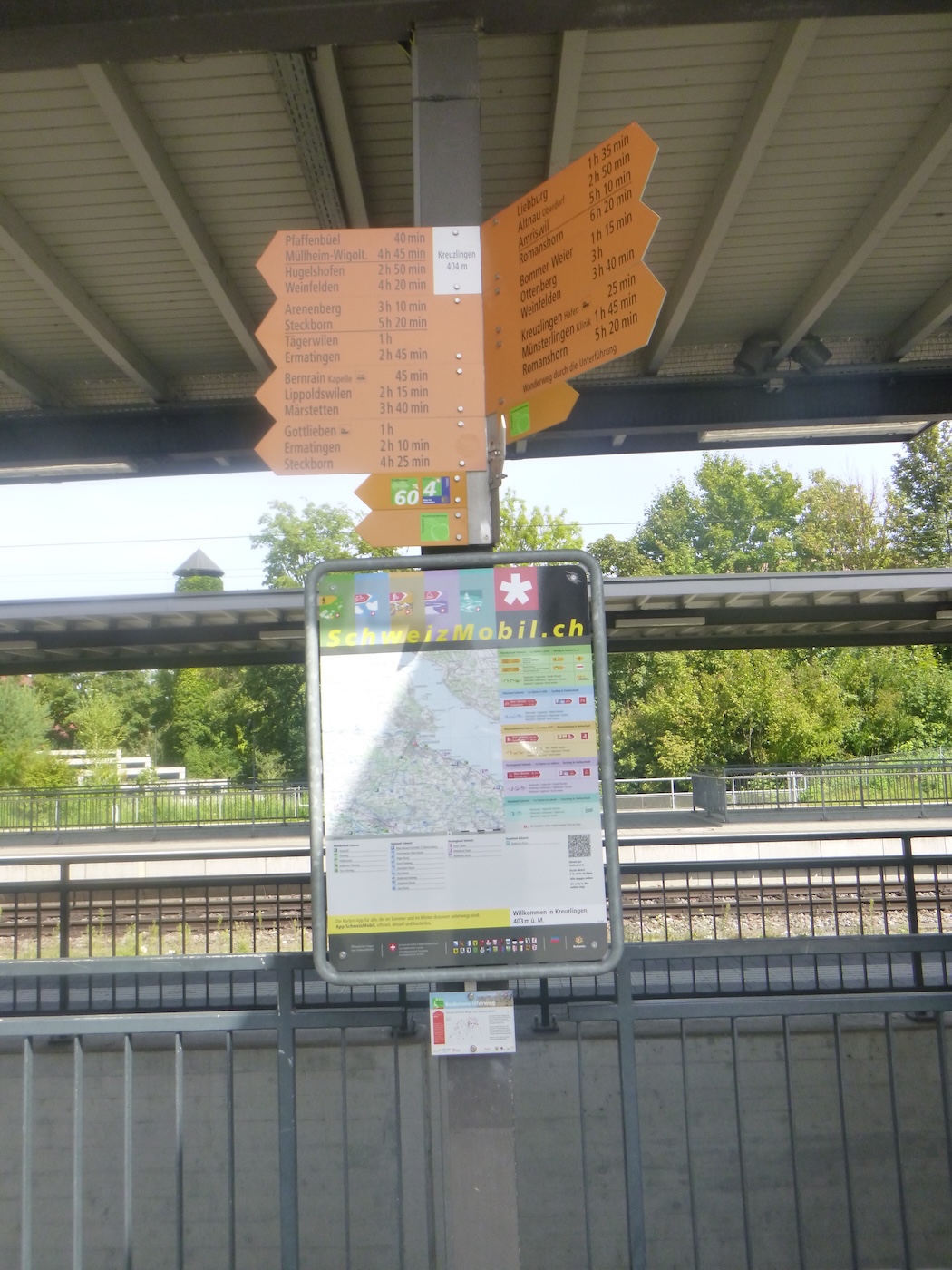
| The Via Jacobi, this common way rediscovered, reveals its route by crossing to the other side of the station, threading through the urban fabric like yarn woven by the skilled fingers of time. |
 |
 |
| Then, like a delightful escape, it drifts into the meanders of the suburbs, its contours bending around a roundabout, like a skilled dancer moving on a stage of concrete. It heads down Rheinstrasse, escaping toward unknown horizons where each house seems to be a note in an increasingly unorchestrated urban symphony. |
 |
 |
| In this symphony, now barely urban, the route takes a right-angle turn, descending Wetstrasse with the majesty of a seasoned traveler, navigating between the shadows of suburban pavilions, immutable witnesses to reassuring simplicity, silent guardians of a certain idea of familial bliss, a haven of peace at the heart of urban hustle. |
 |
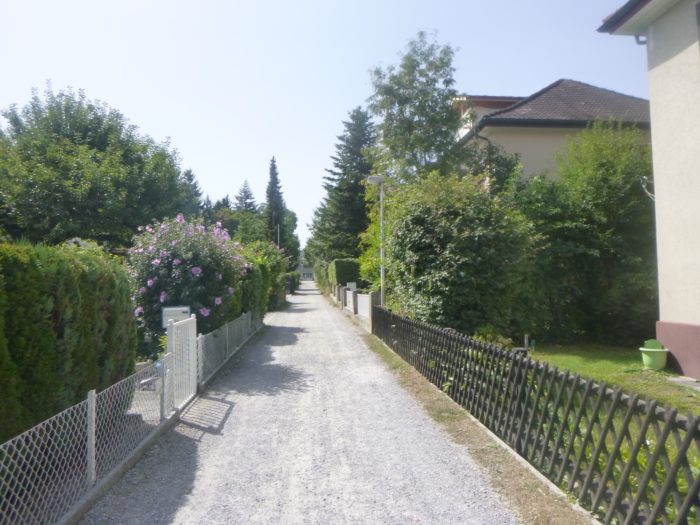 |
| The route, defying the ordinary, then ventures onto Irseerstrasse, where modern industry rises like a cathedral of glass and metal, its spires pointed towards the sky like materialized prayers. |
 |
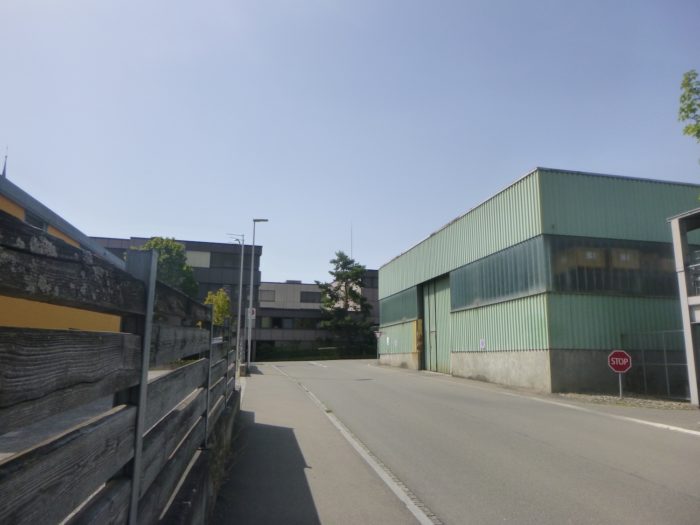 |
| Yet the Via Jacobi, eternal explorer, knows no rest. It reaches another suburb, that of Bernrain in Kreuzlingen, where Unterseestrasse lays down its asphalt carpet beneath hurried footsteps. The pilgrim will not remember Kreuzlingen for any luminous splendor; truthfully, it’s rather monotonous and unsurprising. |
 |
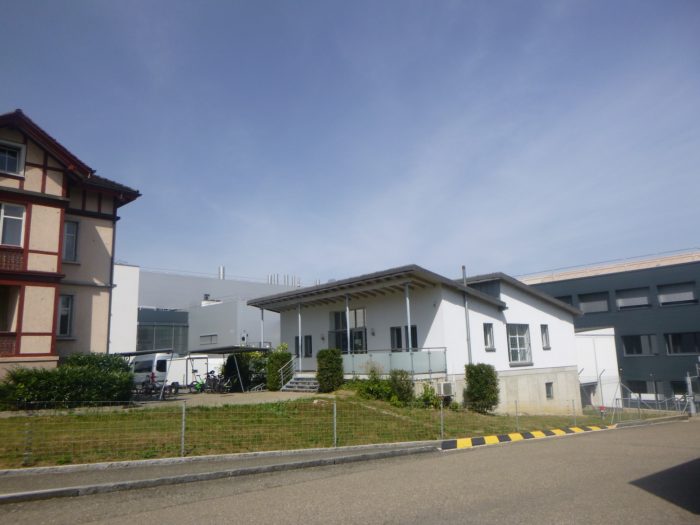 |
| In the gentle cadence of a stroll, shortly thereafter, your steps venture onto Esslenstrasse, an avenue where majestic traditional Thurgau houses blend subtly with contemporary pavilions, presenting a kaleidoscopic architectural feast for the curious soul. |
 |
 |
| You arrive at the end of this eternal crossing of Kreuzlingen, spanning over 5 kilometers. It is also for this reason that it is better to follow the alternative route via St Gall, starting from Lake Constance. Exiting at Rohrschach, you are directly in the countryside. |
 |
 |
| Then, like a crescendo, appear the final notes of this urban composition, in the discreet magnificence of Mühlestrasse. Homes adorned in all their splendor, modern housing developments where comfort blends with elegance… |
 |
 |
| …and the Via Jacobi passes under the railway bridge, leaving the urban agglomeration definitively. |
 |
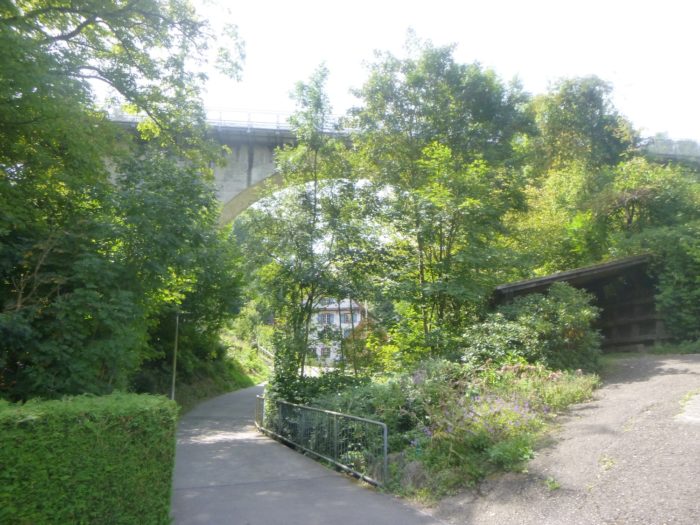 |
In the shaded confines of the countryside, where the peaceful murmur of the Saudbach stream blends with the singing of birds, the old mill, Alte Mühle, stands majestically, an immutable witness to the passage of time. Nestled in the hollow of this verdant valley, it embodies the secular history of this land, where each stone is imbued with tales of yore.
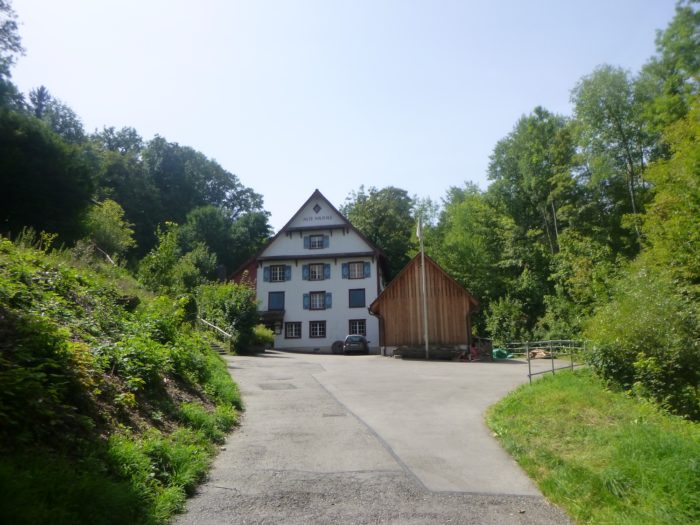
| With light steps, you then finally engage on the winding paths. Soon, you discover a paradise corner, where modest stairs blend harmoniously into the wooded landscape, leading you to a welcoming clearing, ideal for tranquil picnics. |
 |
 |
| But your journey is just beginning. A demanding ascent looms on the horizon, challenging your courage and endurance. Like a pilgrim on the path of faith, you climb the steep slopes of the Way of the Cross, where each step is an offering to determination and perseverance. For nearly a kilometer, you will embrace the verticality with fervor, until reaching the summit. |
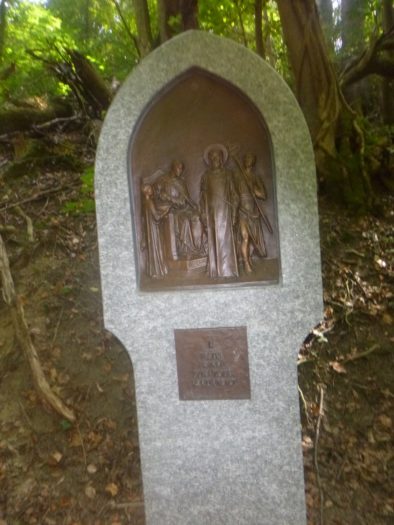 |
 |
| The Way of the Cross gracefully slopes up along the Saudbach stream, a thin trickle of water that meanders with a gentle melody through the valley’s twists. In places, it forms cascades, offering vistas of striking beauty, where sunlight dances on its crystal-clear waters, creating silver reflections. |
 |
 |
| This is the majestic realm of beeches and maples, where each tree seems to be the vigilant guardian of a millennial past. All around, welcoming benches invite the walker to take a break, catch their breath, and contemplate the splendor of the surrounding nature. For the Way of the Cross, far from being solely a trial of suffering, is also a silent witness to the life that pulses in every nook. Sometimes, the light barely filters through the dense foliage, creating shadows and lights worthy of the greatest paintings. |
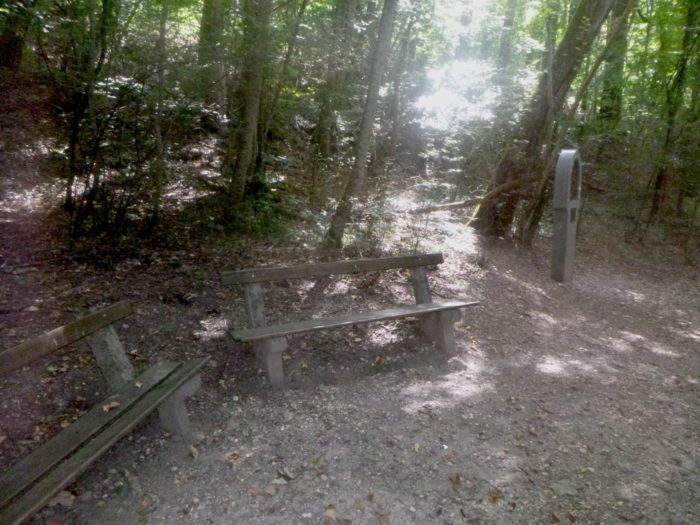 |
 |
| Higher up, the woods gradually clear, revealing the azure sky. The slope, once steep, seems to soften slightly, as if to reward the persevering pilgrim’s efforts. |
 |
 |
| Soon, a wooden bridge proudly stands, offering a passage to the other side of the stream. Its planks, polished by time, resonate under your steps, like a discreet echo of your progress on the path. |
 |
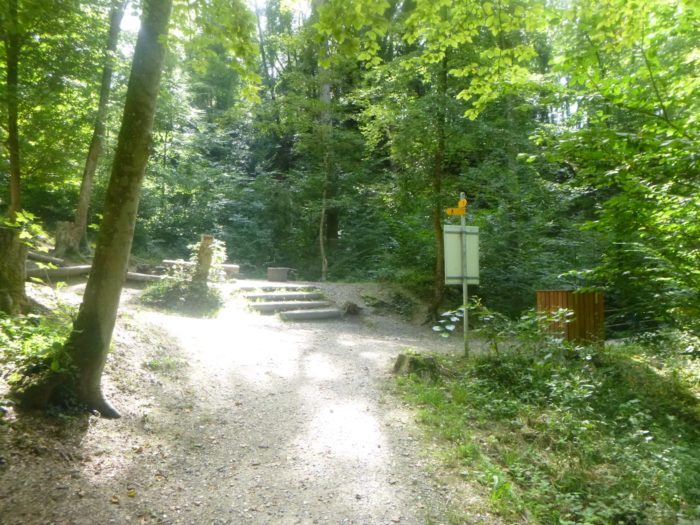 |
| The path then snakes near a fountain, where clear water springs forth with a soft melody. Around, new benches invite a well-deserved break, offering a moment of respite before continuing the ascent. |
 |
 |
| For the climb is not yet finished, far from it! Two grand staircases rise before you, like proud sentinels of a medieval castle, inviting you to climb even higher the peaks of existence. |
 |
 |
| At the summit, like a long-awaited jewel after a strenuous effort, lies the well-deserved rest. The path concludes at the end of this long and intense ascent, giving way to a sense of fulfillment and satisfaction. |
 |
 |
 |
 |
| Just a stone’s throw away proudly stands the Heiligkreuz Bernrain Pilgrimage Chapel. It is the first chapel on the Way of St. James leading from Constance to Einsiedeln, a timeless witness to spiritual journeys and solemn moments. Under its protective roof, faithful and travelers find refuge and inspiration. Built in the 14th century, it is steeped in history and devotion, bearing witness to centuries of faith that have permeated this sacred land. But it is also a place where earthly joys blend with prayers, as the chapel is also the setting for weddings, celebrating love under the benevolent gaze of the divine. An ancient legend hangs in the air, recalling the importance of faith and promise. It is said that a young boy, showing irreverence to the Lord, miraculously found himself bound to the crucifix until his mother and the town’s notables promised him a pilgrimage to Einsiedeln. Only then was his hand released from its grip, forever marking the importance of repentance and devotion. |
 |
 |
| From the chapel, a smooth and winding path gently winds through the woods, offering walkers an enchanting journey through the majestic deciduous trees that populate these lands. Beeches and maples stand with incomparable nobility, their foliage shading the path with a mystical aura. Here, the presence of oaks is rare. |
 |
 |
Section 3: Between woodland and countryside
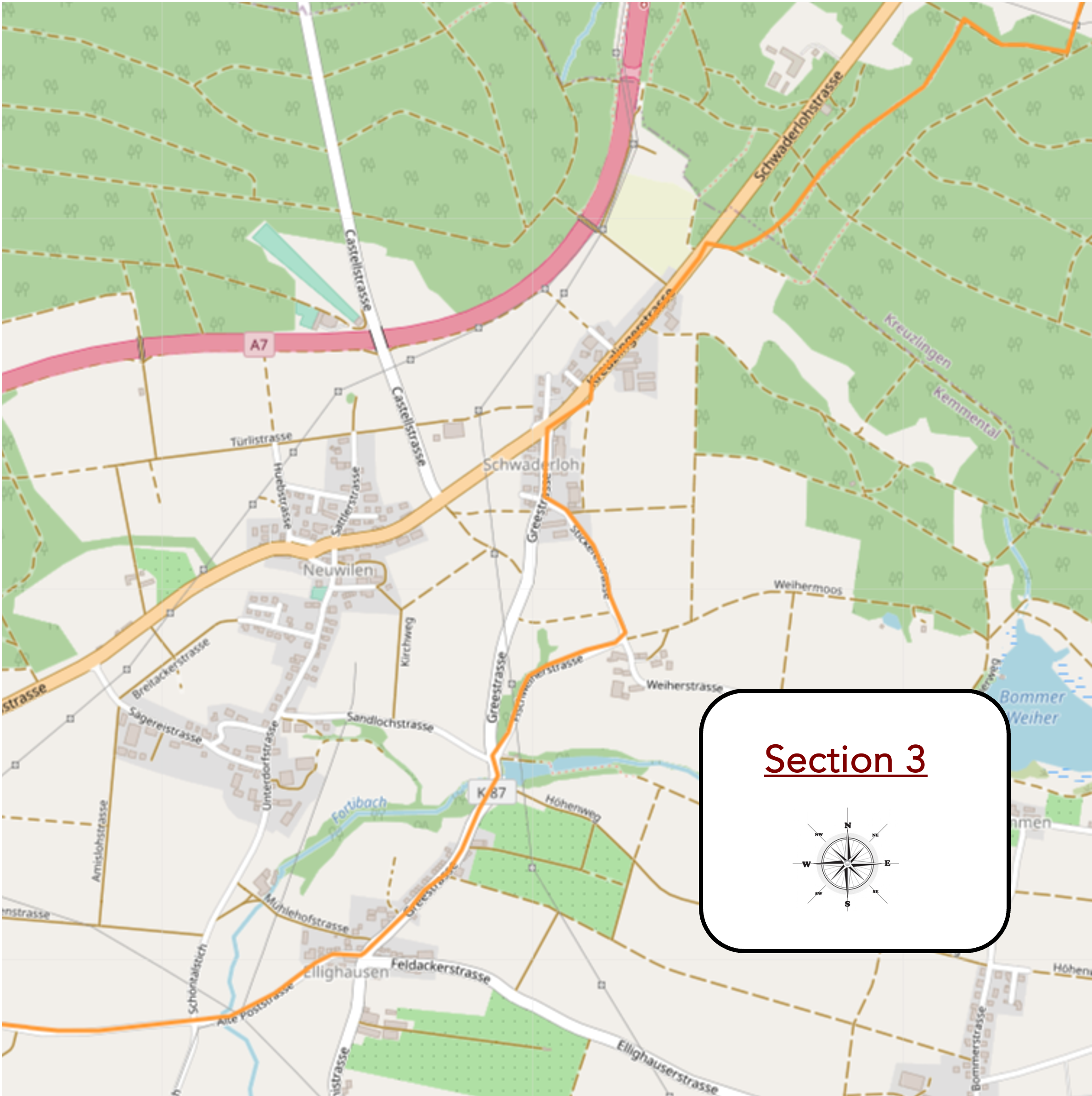
Overview of the route’s challenges: course without any difficulty.

|
A wide path opens up before you, meandering through a magnificent beech forest where once upon a time, health trails were in vogue, bearing witness to a bygone era where well-being and health were more central concerns. Despite changing attitudes, these trails are still frequented by joggers on weekdays and Sundays.
|
 |
 |
| Many woodcuts still remain in Swiss forests, especially when beech, the main source of heating, is at stake. |
 |
 |
Further on, the path crosses a vast clearing near a main road, offering a striking contrast between the tranquility of nature and the hustle and bustle of modern life.
|
 |
 |
However, the escape quickly resumes its rights as the path slips again under the cover of trees, where piles of wood testify to human activity and the reasoned exploitation of the forest. The forest unfolds its beauty generously. Airy and welcoming, it invites one to effortlessly wander beneath its benevolent canopy.
|
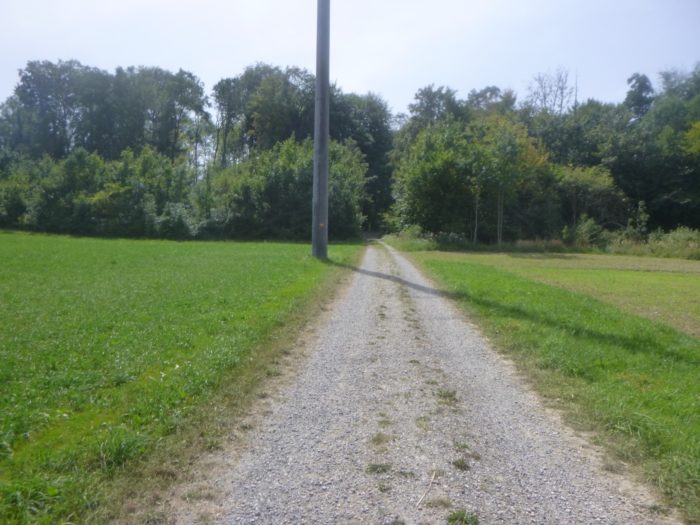 |
 |
| In the depths of the undergrowth, the path is sometimes adorned with small stones, adding a rough texture to its surface, while the light filtered through the foliage creates plays of shadows and lights, giving the woods a serene aura. |
 |
 |
| Further along, the path narrows, winding between the slender maple hedges, before opening onto a wide lane, under the majestic dome of beeches that stand like immutable sentinels. |
 |
 |
| At the edge of the woods, where the tree shadows mingle with the first rays of sunlight, the route harmoniously merges into a winding road, crossing the vast green meadows that stretch into the distance. |
 |
 |
| It is at this precise point that the Via Jacobi joins the tranquil animation of this country road, following along the sidewalk of the main axis connecting the towns of Kreuzlingen and Märstetten. |
 |
 |
| The road then gently guides you to Schwaderloh, a haven of tranquility in the heart of the countryside. It is here, between wooden fences and wrought iron gates, that the authentic portrait of a rural life imbued with simplicity and serenity is drawn. |
 |
 |
At this precise location, an imposing direction sign welcomes you kindly, clearly indicating that Via Jacobi 4 continues its journey towards Ellighausen, promising you a discovery trip through the changing landscapes of eastern Switzerland.

| The farms scattered throughout the surrounding countryside captivate with their rustic beauty and timeless authenticity, with their shingled walls proudly standing against the sky, evoking an eternal sense of stability and tradition, as is customary in eastern Switzerland. |
 |
 |
| In Schwaderloh, Via Jacobi abruptly turns onto a small road, revealing new horizons to explore, an invitation to discover the hidden secrets of Swiss countryside. |
 |
 |
| The route then winds its way through fertile fields, following a stretch of gravel road that gracefully snakes through the heart of the deep countryside. |
 |
 |
| Further on, the road elegantly turns, marking the transition between the rusticity of country roads and the comfort of asphalt, amidst meadows and cultivated fields, towards Bommen. |
 |
 |
| Yet, the route seems deliberately to ignore the village and its farms that stand in its way… |
 |
 |
| … preferring to veer decisively to the right, peacefully returning among the meadows to meet the cantonal road. This sudden decision reflects the planners’ desire for hiking trails to follow the meanders of the landscape rather than be guided by human constructions. |
 |
 |
| It is at the entrance of Elligshausen that the Via Jacobi rejoins the cantonal road, where it once again merges with the sparse flow of vehicles on this axis. |
 |
 |
| PShortly after, there’s a trap you shouldn’t fall into. There’s a direction sign on the road, inviting you to take that path. It’s a beautiful dirt road that goes through meadows and orchards in a bucolic nature amidst small lakes. But here’s the catch! It’s not your path. But how do you know if you should keep going straight?
So, you’re entitled to a little explanation. Swiss cartographers don’t favor any route. Via Jacobi 4 is a route like any other. And too bad for the pilgrims! Swiss cartographers are stubborn. It’s their policy, and they won’t change it. Figure it out. Most of the time, the signage is a little figure on a yellow background. But the little figure doesn’t tell you which path you’re on. Only at major intersections will you be indicated Via Jacobi 4. The cartographers of the GR (Great Hiking Trails) in France and Spain are friendlier. They’ve plastered their routes with signs to tell you which direction the trail takes, and especially which route not to take, which is even more important. That would have been very useful here, instead of going 5 km in the wrong direction and turning back after realizing you’ve made a mistake. That’s also why it’s better, in Switzerland, to plan your route in advance using guides and not just leave it to chance, as you can do in France or Spain. |
 |
 |
Indeed, after a few more steps through the village, the keen eye can finally discern the discreet indication of the direction of Via Jacobi 4. A welcome relief that reminds you of the importance of staying attentive to the slightest signs on the trail, even if they are confusing before the village.

| The village stretches with a robust appearance, its sturdy farms evoking a rich history and a united community. In the distance, a road rises gently towards a hill that looms on the horizon, crossing the peaceful Fortibach stream. |
 |
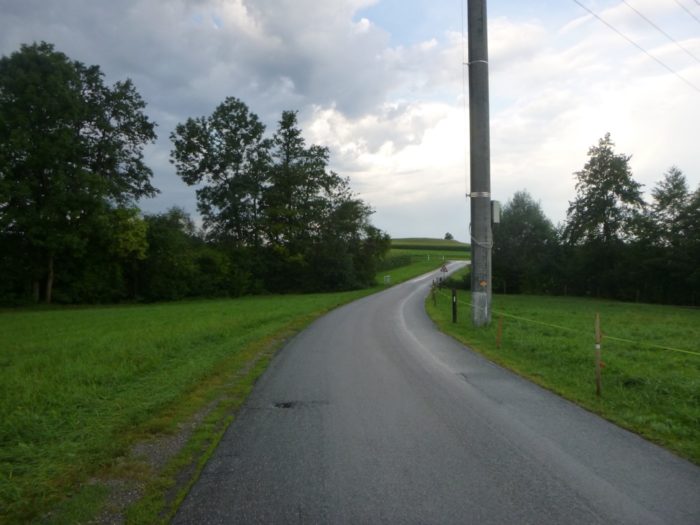 |
| Then, between vast green meadows and fields of corn swaying in the wind, the road snakes with ease, offering travelers an unobstructed view of the simple and authentic beauty of the Swiss countryside. |
 |
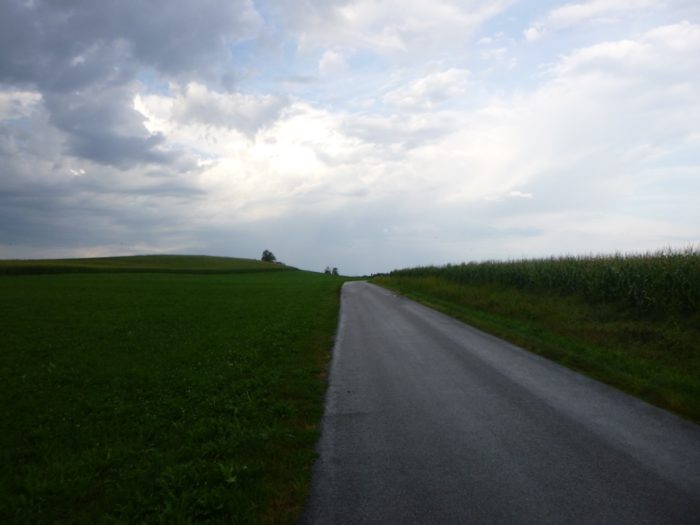 |
Section 4: Between woodland and countryside

Overview of the route’s challenges: The route presents no particular challenges.

| In this sun-drenched region where groves are sparse, cultivated fields stretch endlessly like a sea of green. The remarkably fertile land offers its bounty to farmers who tend to it with care. Amidst the orderly rows of crops, even cabbages find their place, adding a splash of color to this rural tableau. |
 |
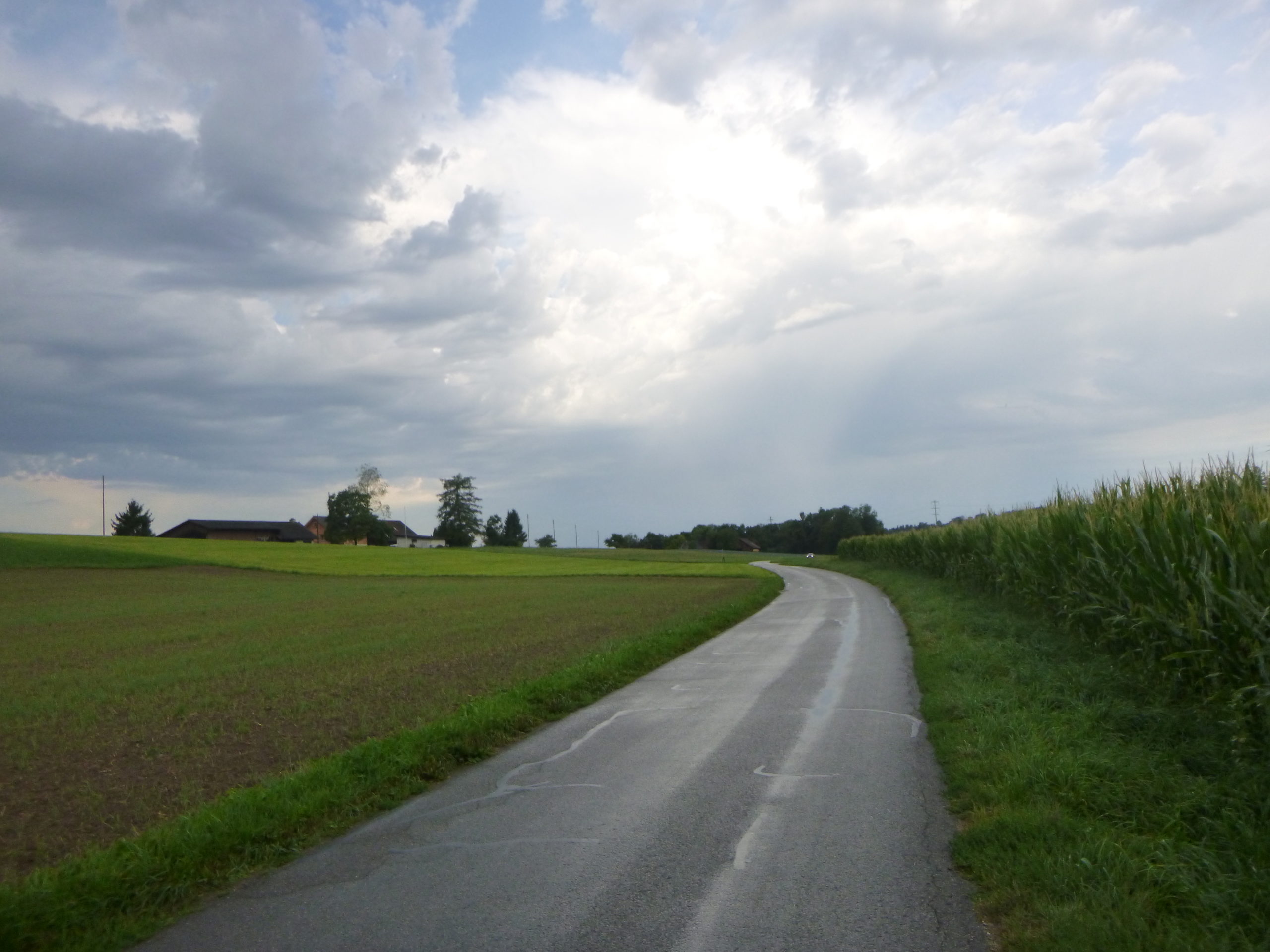 |
| Yet, despite the abundance of crops, occasional common patches dot the vast green expanses. It is here that cows peacefully graze, living symbols of Swiss pastoral life. Their presence is comforting. However, it’s curious to note their relative scarcity today, an anomaly in a region where herds are often a familiar sight. |
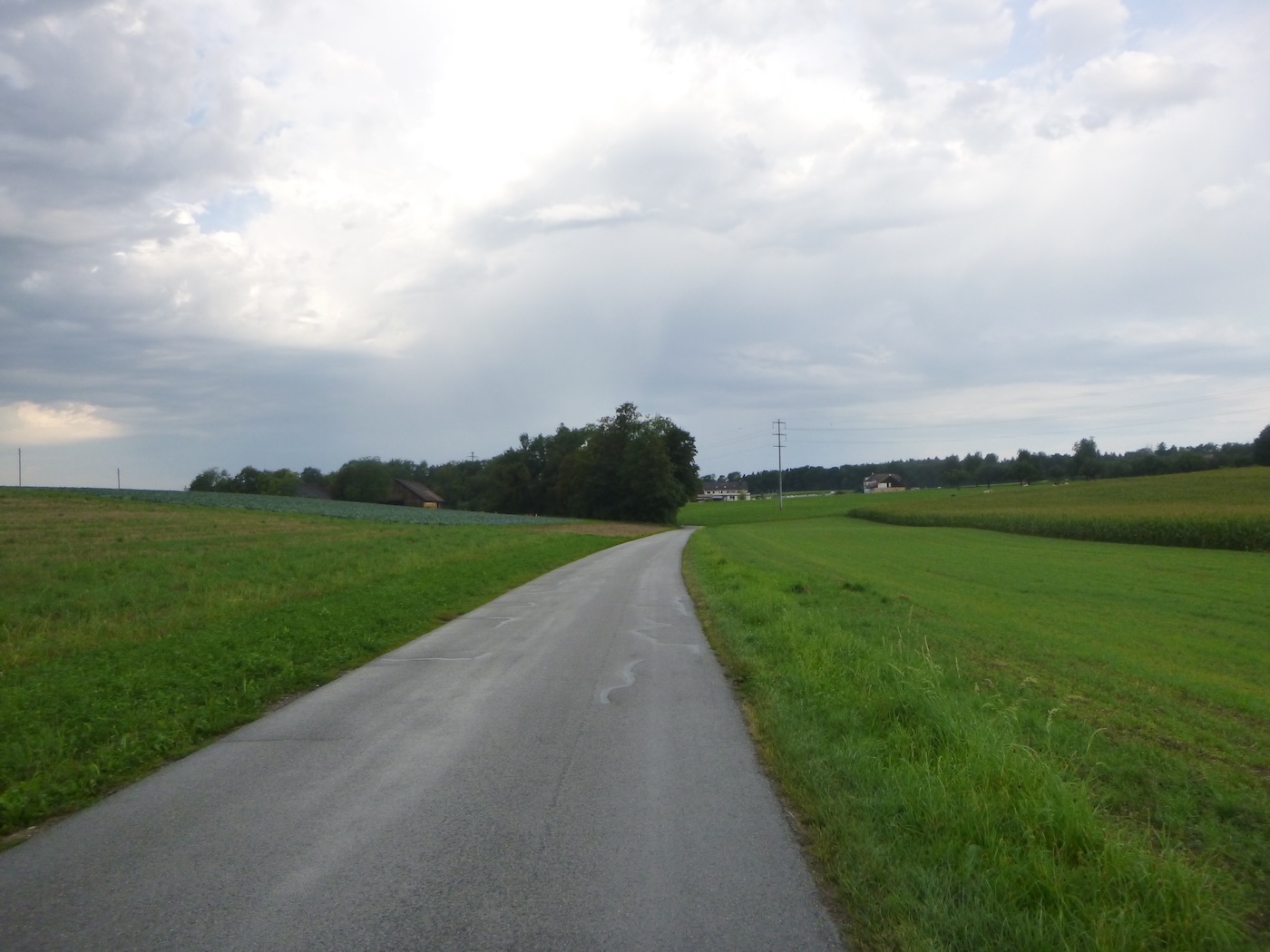 |
 |
| As you approach Lippoldswilen, the landscape begins to subtly change. Fields still stretch out, but scattered buildings hint that the village is within sight. |
 |
 |
| When Lippoldswilen finally reveals itself, its contemporary charm contrasts with the older buildings of previously traversed villages. Their clean lines and modern facades speak of a different, more recent history. Typical of Protestant regions, this village is not often endowed with places of worship, a peculiarity that speaks volumes about the religious traditions that have shaped these Protestant lands over the centuries. |
 |
 |
| Once beyond the village limits, the Via Jacobi confidently delves into the mysterious woodland ahead, drawn by the promise of adventures to come. |
 |
 |
|
Shortly after, the dirt road replaces the paved road, adding a rustic touch to your journey. This transition marks the beginning of total immersion in the surrounding nature, where each step brings you closer to the heart of the forest.
|
 |
 |
|
Hesitant to enter directly into the depths of the woods, the path seems to leisurely meander at the edge of the trees, as if savoring one last glimpse of daylight before plunging into the darkness of the foliage.
|
 |
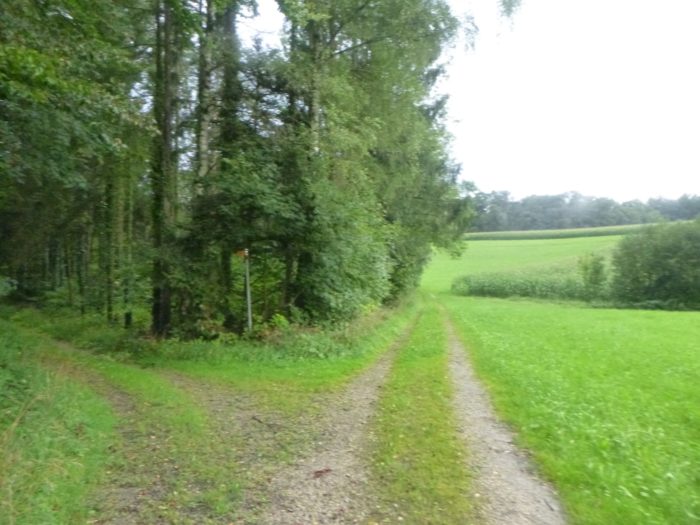 |
|
But finally, it resolutely sets off, leaving behind the last rays of light to plunge into a path in the dimness of the undergrowth.
|
 |
 |
Here, among the dominant beeches and maples, a few solitary spruces stand, adding their dark silhouettes to this mysterious universe. In the heart of this vegetal sanctuary, a scallop shell of Compostela appears, a discreet yet powerful reminder of the spirituality that permeates these lands, and above all, a sign telling you that you are on the right path.
|
 |
 |
The darkness envelops the woods with a mysterious aura, almost obliging the walker to carry a flashlight to pierce the darkness. At the bottom of the dale, the Chemibach murmurs peacefully, offering a soothing counterpoint to the dark and subdued atmosphere that reigns in these places. Yet, the descent remains gentle and accessible, far from the imposing verticality of the mountains.
|
 |
 |
Observing Swiss signage reveals an intriguing peculiarity: another path looms on the horizon, but the sign clearly indicates the direction of the Via Jacobi. A welcome novelty, especially after Elligshausen, where this practice was not observed at all. The mention of the remaining time to Märstetten, about 1 hour, completes this information, adding a practical touch to your walk.

| With infinite grace, the trail adorns itself as it crosses the stream, offering hikers a welcome break near a carefully landscaped picnic area, where walkers can enjoy a moment of rest in the shade of the trees. This stop seems ready to welcome visitors during heatwaves, offering a refreshing and invigorating refuge. |
 |
 |
| Like a gradual awakening, the Via Jacobi brings back the daylight on a wide path, gently moving away from the dense woodland and the soothing murmur of the stream, guiding their steps towards the next stop: Wald. |
 |
 |
It is at this precise point that the announcement of accommodation in Märstetten resonates like an oasis in a desert, particularly in this region where lodging options are scarce. This information always proves to be a breath of fresh air for travelers, an assurance of finding a haven of rest and comfort after a busy day of walking.

| As the path begins to climb slightly on almost clayey soil, every step becomes a challenge to overcome in case of bad weather. |
 |
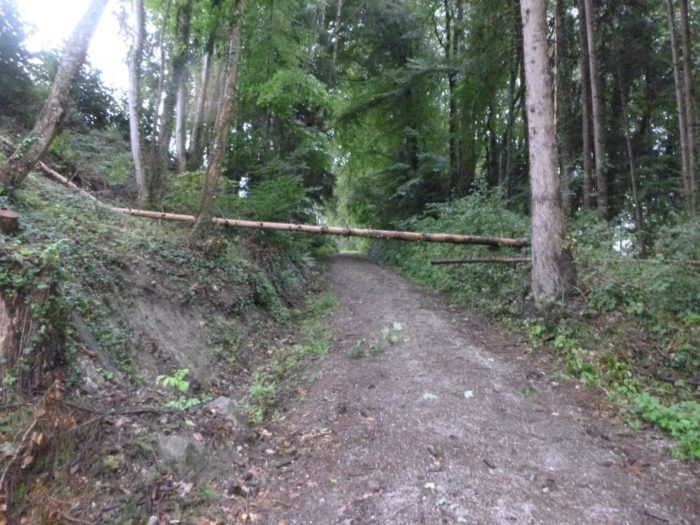 |
| Shortly after this ascent, the path leaves the woodland to cross the hamlet of Etenmoos, a place located only an hour’s walk from Märstetten. There, amidst the vast green expanses, cows, peacefully settled, seem to welcome visitors with their gentle and curious gaze, adding a touch of life to this rural scene. |
 |
 |
| Here, a road, winding and gentle as a caress, climbs the hill with striking elegance, offering travelers a panoramic view of the surrounding landscapes. As it slopes up, it tells a millennia-old story, that of fertile lands and isolated farms of Riet that loom in the distance, like relics of a still-present past. |
 |
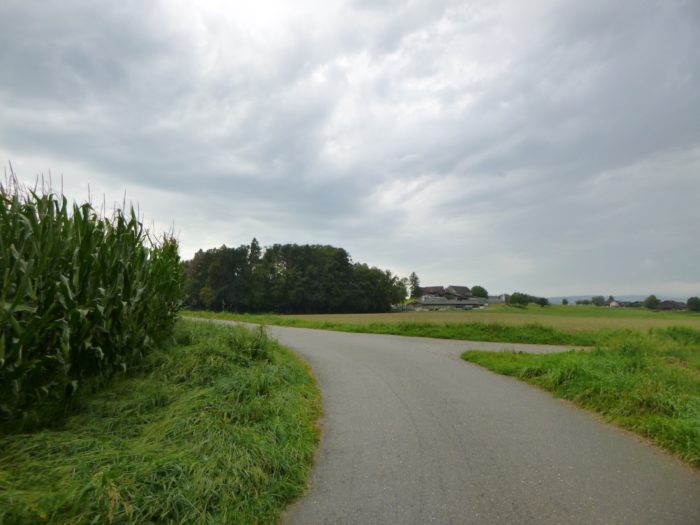 |
| The farms that punctuate this landscape, perfectly maintained and adorned with wooden crosspieces, testify to the rigor and craftsmanship of the inhabitants who reside there. Every detail seems to have been carefully thought out, in constant pursuit of harmony and beauty. And even the manure, usually omnipresent near the houses, is relegated to a certain distance, thus respecting the integrity and cleanliness of the place, in line with the exemplary rural life of German-speaking Switzerland. |
 |
 |
| In the distance, the route crosses a small road, continuing its steadfast course on a grassy path through the endless expanses of the countryside. |
 |
 |
| The sky, darkened for several hours already, pours benevolent rain onto the soaked path, transforming the fields and surrounding crops into a vibrant and lush tableau. |
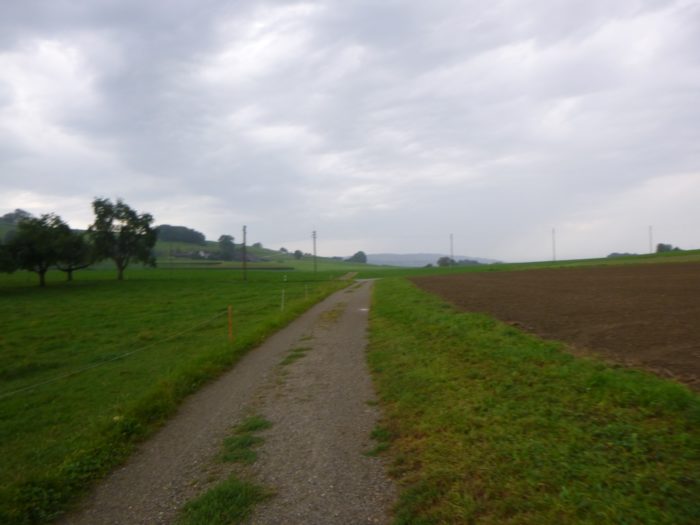 |
 |
| The path then begins to gently climb towards Wald. It is in this vast countryside that the soul finds refuge, where peaceful silence and benevolent solitude envelop every thought and every step with ineffable gentleness. |
 |
 |
| In Wald, a small hamlet with picturesque houses lining the road, the tranquil rhythm of life flows like a soft melody. The farms, proud guardians of ancestral traditions, add an authentic touch to this postcard-perfect rural scene. And the presence of a bus stop here reminds of the remarkable accessibility of the place, a characteristic of the Swiss public transportation system. |
 |
 |
In Wald, you are only 45 minutes away from Märstetten.

Section 5: Märstetten, a nearly compulsory stop to find overnight accommodation

Overview of the route’s challenges: The route presents no particular challenges.

| After briefly skirting the asphalt, the Via Jacobi, true to its essence, reverts to dirt, like a dancer finding their rhythm on a familiar stage. |
 |
 |
| There, before the walker unfolds a living tableau of the countryside, where isolated farms stand like sentinels amidst vast expanses. Meadows gently undulate, while crops unfold into a colorful patchwork, like a visual symphony embedded in the landscape. It’s the countryside that soothes the soul. |
 |
 |
| Around the bend of the path, a scene of great serenity reveals itself: gleaming cobblestones, akin to scattered jewels, border a sumptuous mansion nestled in the woods, in a place that already evokes a thousand legends: the mysterious Hinterer Ruberbaum. You would gladly drop your bags in this paradise tucked away in the woods. |
 |
 |
| A small road, like a winding river, then meanders at the edge of the woods, in the shade of magnificent beeches that reach for the sky… |
 |
 |
| …before joining a small road that leads to Märstetten Village. |
 |
 |
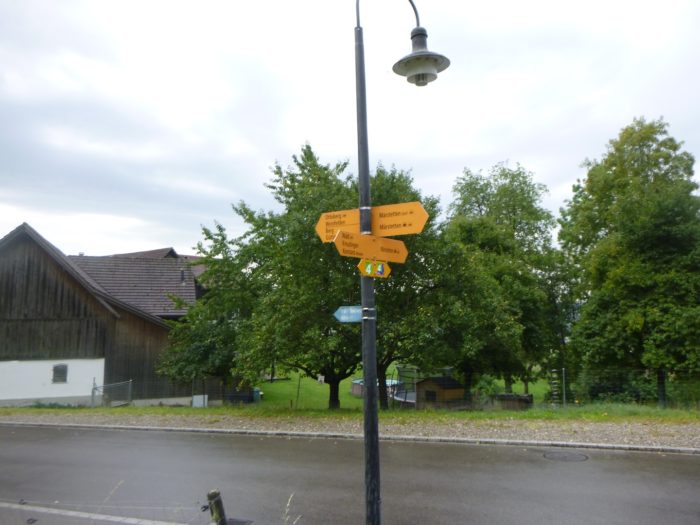
It is at this strategic crossroads that the roads diverge, as the Via Jacobi does not stop at Märstetten. It continues straight ahead, towards Tobel, like an arrow launched towards the horizon. But sometimes, it is necessary to take a break, to find shelter for the night.
If the urge to linger in Märstetten strikes you, two choices await you, like crossroads in your own journey. You can take the road that leads straight to the heart of the town, or continue a little further on the Via Jacobi’s trail. However, our advice is to continue on the Via Jacobi, to follow its path with rigor and determination. For in doing so, you will know the next day where and how to resume your journey, at the very exit of the town, without getting lost in the mazes of uncertainty. It is undeniable that in these regions where stops are rare, the choice to stay overnight depends mainly on your endurance. You are not walking in a highly touristic area.

| On the Via Jacobi, a trail plunges with quiet determination into the thickness of a dense woodland, where light struggles to penetrate. It is a mysterious undergrowth that reveals itself drop by drop. |
 |
 |
| Further on, a large path is lulled by the murmur of a stream, like a melodious companion in this symphony of nature, flowing slowly along the cornfields. |
 |
 |
| Soon, the imposing silhouette of Märstetten’s industrial area emerges before the hiker, delineated in the background of the cornfields, like a contemporary monolith watching over agrarian traditions. Like a striking contrast between the hustle and bustle of human activity and the tranquility of the surrounding nature, this vision reminds walkers of the duality of the world they traverse. |
 |
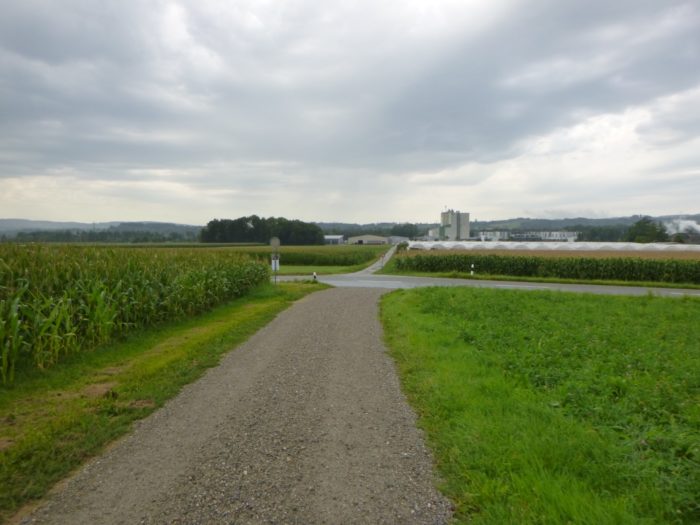 |
| Just after, the greenhouses of horticulturists offer a profusion of strawberries, an oasis of colors and flavors in this rustic landscape. |
 |
 |
| It is important not to be led astray by the temptations of secondary paths offered to reach the heart of the town. The preferred route proves to be a route of wisdom, direct and without detours, straight through the industrial area. |
 |
 |
You will then arrive at the road that leads out of Märstetten. This is where you will return the next day to continue your journey.

| Here, you will follow the Via Jacobi in the opposite direction for a few hundred meters, along the road that leads to the small town. |
 |
 |
You will then arrive at Märstetten train station. Like an imposing structure emerging from the modesty of the town. Märstetten train station stands as a monument to the grandeur of travel. Its imposing stature, incongruous in this rural setting, testifies to the discreet prosperity that reigns in these Swiss territories. Indeed, in this country where abundance flows like a clear stream in the dales, even the humblest towns can boast infrastructures of unsuspected opulence.

| Märstetten, populated by its 2,900 souls, proudly stands as the undisputed bastion of the region. To reach the old village, you must venture down a long straight street that seems to stretch to infinity. In this land where hospitality is sparing, accommodation options are as rare as nuggets in the sand. |
 |
 |
Accommodation on Via Jacobi
- Camping Fischerhaus, Promenadenstrasse 52, Kreuzlingen; 071 677 49 03; Gîte, breakfast
- Jugendherberge, Promenadenstrasse 7, Kreuzkingen; 071 688 26 63; Youth hostel, dinner, petit déj
- Ferienwohnung Grenztor, Grenzastasse 23, Kreuzlingen; 071 558 56 06/076 524 42 97; Guestroom, breakfast
- Hôtel Bahnhof, Nationalstrasse 2, Kreuzlingen; 071 672 79 72; Hotel, dinner, breakfast
- B&B Cludia Rufer, Greestrasse 25, Ellighausen; 071 699 17 57/079 600 05 69; Guestroom, dinner, breakfast
- Pilgerherberge, Hubstrasse 2, Märstetten; 077 512 58 31; Gîte, breakfast
- Claudia Brenner, Ebvenhüssli, Märstetten; 071 657 17 90; Guestroom, breakfast
- Klingenmühle, Klimgenmühle 1, Märstetten; 071 659 00 11; Guestroom, dinner, breakfast
At this stage, the possibilities of finding accommodation are limited. You can indeed find everything you need in Kreuzlingen, but you won’t linger there much. From Kreuzlingen, there are neither restaurants nor supermarkets to dine at. However, in Mârstetten, you will find restaurants and supermarkets. It is imperative to book your accommodation at all costs, as it is unlikely to find other accommodations further on, unless you are willing to cover many extra kilometers.
Feel free to add comments. This is often how you move up the Google hierarchy, and how more pilgrims will have access to the site.
|
 |
Next stage : Stage 2: From Märsttetten to Münchwilen |
|
 |
Back to menu |
























